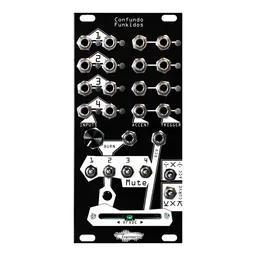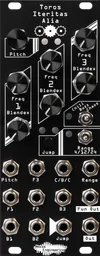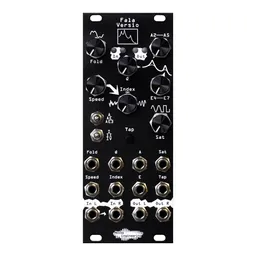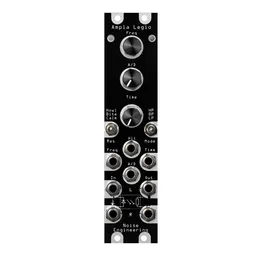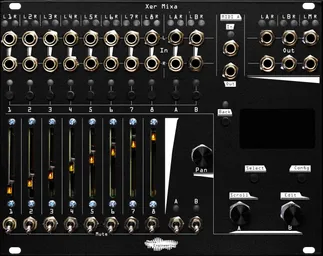By now, you’ve probably heard the news: there’s a new mixer in town. Last week we officially announced Xer Mixa and its expander, the aptly named Expando Expandi.
Xer Mixa has a whole lot of features, and we designed it to fit into as many different workflows as possible. Next week, we’ll chat in detail about Expando Expandi and the possibilities that CV control offers. We also have plenty of content planned in the future regarding various workflows, tips, and tricks – make sure you’re subscribed to our YouTube channel and watch this space for more.
Xer Mixa: it’s a whole lotta mixer

As you can see from the panel, Xer Mixa has a lot of ins and outs. It has 8 channels plus two aux input channels, two aux outputs, and a main output. All of the channels will take mono or stereo inputs, including the aux sends and returns, so if you have a bunch of stereo voices that you’d like to route through some stereo aux effects, you can!
Each of the main channels has a dedicated volume fader and clickless mute switch, designed for a hands-on and simple approach to jamming and performing. The channel LEDs reflect mute status and the fader LEDs show the channel level. If you’re on the main meter screen, you can easily keep an eye on your levels, and adjust the main, A, and B output levels with the three encoders.
Speaking of levels, Xer Mixa’s all-analog design allowed us to keep things quiet with a low-noise, low-crosstalk design. It also has absurdly high headroom: about 22 volts peak-to-peak. In testing, we were never actually able to get the mixer to clip even with the most ridiculous voices in our systems.
Pan and sends
Pan and send editing is done via the encoders: tap a channel button and use the Pan, A, and B encoders to adjust pan position and send levels. Multiple channels can be selected at once, too, making for easy adjustments to many channels with a single control.

Each channel can be configured individually by tapping the Config button. Each channel has settings for pre or post effects sends, pan law, and output options that change how the channel interacts with the main and aux outputs.
All edits made with the encoders are saved on the fly, so your mix will always sound the same between power cycles. We also added a way to save and load scenes, which contain data for track panning and send levels, expander configuration, and more settings that can be saved and recalled from a dedicated menu, or with MIDI.
Leveling
Xer Mixa’s all-analog audio path means that your patch never goes through an analog-to-digital or digital-to-analog conversion process: it just goes through some analog summing, then it’s routed to the outputs. This did limit the audio processing options we had, but we added an optional leveling amplifier to the outputs. This is a relatively subtle, but very pleasant, way to add some glue and punch to your mix.
And yes, it goes to 11.
Just tap Config from the main meter screen and configure it from the Audio menu.
Cue
Another option in the Audio menu is to use the B output as a cue output instead of an aux send. Modular is all about options: Xer Mixa’s only goal was mixing and routing, and as such it only has Eurorack-level outputs. But paired with a headphone adapter, cue is a great performance tool that lets you hear a mix of channels before your audience does. Cueing can be selected either by mute switch or with channel selects, and the cue output can contain just the cued tracks or the whole mix.
MIDI
If you’d like to automate your mix with external controllers, or record fader and mute movements to a DAW, Xer Mixa has MIDI in and out jacks so you can do just that. Scenes can be loaded with program-change messages, too, and you can even back up or load scene data via SysEx.
Each fader and mute switch have their own CCs that they output and, in turn, respond to. Pan and send levels can be automated with external CCs, too.
MIDI control also adds a lot of options for applying a mix performance to multitrack-recorded stems. If you mult and record all of your inputs, you can apply your level changes and mutes later on in the DAW at the editing stage, perfect for creating a pristine multitrack mix. We’ll have a whole blog post about this workflow later on!
CV? Oh, we’ve got CV.
If you want CV control, Xer Mixa has a highly configurable modulation system based around its expanders. You can connect up to two Expando Expandi, for 16 CV inputs that can be routed to up to 32 destinations. We’ll chat a lot more about the expanders and CV in next week’s post, so stay tuned.
Tennis
Tennis? Tennis.
For when we need a break from testing.
Do jacks go on the bottom or the top? You decide
We’re big fans of flexibility, and we like our modules to reflect that. In our cases, we sometimes find it helpful to have the jacks on the top of the mixer, and sometimes they’re better suited on the bottom. We added an option to the menu that reverses the screen, the faders, and the mutes. This makes it easy to use Xer Mixa in whatever orientation fits your case best.
Baby buy buy buy
Xer Mixa and Expando Expandi are both available for preorder now, and begin shipping on September 6th. If you buy both together as a bundle, you get a discount, too! If you’d like to add one to your rack, order now from your favorite retailer or our webshop to get yours as soon as possible.
If you’d like to learn more about what Xer Mixa can do, you can check out the full user manual here.
